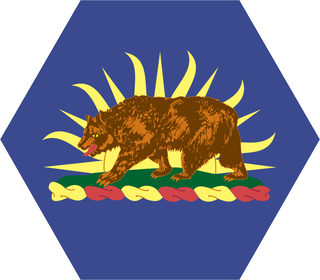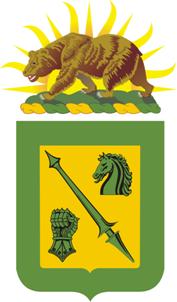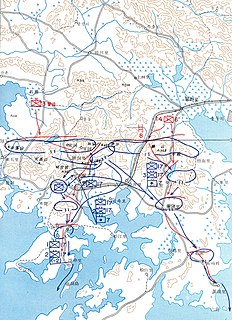
The 2nd Infantry Division is a formation of the United States Army. Its current primary mission is the pre-emptive defense of South Korea in the event of an invasion from North Korea. There are approximately 17,000 soldiers in the 2nd Infantry Division, with 10,000 of them stationed in South Korea, accounting for about 35% of the United States Forces Korea personnel.

The 1st Cavalry Division is a combined arms division and is one of the most decorated combat divisions of the United States Army. It is based at Fort Hood, Texas. It was formed in 1921 and served during World War II, the Korean War, the Vietnam War, the Persian Gulf War, with the Stabilization Force in Bosnia-Herzegovina, in the Iraq War, in the War in Afghanistan and in Operation Freedom's Sentinel. As of October 2017, the 1st Cavalry Division is subordinate to III Corps and is commanded by Major General John B. Richardson.

The 24th Infantry Division was an infantry division of the United States Army. It was inactivated in October 1996, it was based at Fort Stewart, Georgia and later reactivated at Fort Riley, Kansas. Formed during World War II from the disbanding Hawaiian Division, the division saw action throughout the Pacific theater, first fighting in New Guinea before landing on the Philippine islands of Leyte and Luzon, driving Japanese forces from them. Following the end of the war, the division participated in occupation duties in Japan, and was the first division to respond at the outbreak of the Korean War. For the first 18 months of the war, the division was heavily engaged on the front lines with North Korean and Chinese forces, suffering over 10,000 casualties. It was withdrawn from the front lines to the reserve force for the remainder of the war after the second battle for Wonju, but returned to Korea for patrol duty at the end of major combat operations.

The 40th Infantry Division is a modular division of the United States Army. Following the army's modularization the division has become a four-brigade combat team with National Guardsmen from throughout the Pacific/Western United States and Oceania. Its division headquarters is located at Los Alamitos Joint Forces Training Base in Los Alamitos, California.

The California Army National Guard is one of three components of the California National Guard, a reserve of the United States Army, and part of the National Guard of the United States. The California Army National Guard is composed of 18,450 soldiers. Nationwide, the Army National Guard comprises approximately one half of the US Army's available combat forces and approximately one third of its support organization. National coordination of various state National Guard units are maintained through the National Guard Bureau.

The Battle of White Horse, was a battle during the Korean War hill in the Iron Triangle, formed by Pyonggang at its peak and Gimhwa-eup and Cheorwon-eup at its base, a strategic transportation route in the central region of the Korean peninsula.
The 70th Armor Regiment is an armored (tank) unit of the United States Army. It was constituted as the 70th Tank Battalion in July 1940, an independent tank battalion intended to provide close support to infantry units. In this role, it saw action in the Mediterranean and European Theater of Operations, making assault landings and fighting with the 9th Infantry Division in North Africa, and with the 1st Infantry Division in Sicily. The battalion supported the 4th Infantry Division on Utah Beach during the D-Day landings in France, and fought with the 4th Infantry Division through the remainder of World War II. The 70th Tank Battalion was one of the first three tank battalions to deploy to Korea in the Korean War, where it saw significant action, primarily with the 1st Cavalry Division.

The 185th Infantry Regiment is a unit of the United States Army made up of soldiers from the California Army National Guard, represented by the 1st Battalion, part of the 81st Stryker Brigade Combat Team.

The 18th Cavalry Regiment is a parent cavalry regiment of the United States Army.

The 40th Armored Division was a division of the United States Army National Guard from July 1954 until 1967.

The Battle of Ongjin was a part of the Operation Pokpoong that marked the beginning of the Korean War. The Republic of Korea Army (ROK) 17th Infantry Regiment fought against Korean People's Army (KPA) 14th Infantry Regiment and the 3rd Guards Brigade supported by a tank company at Ongjin.
The 67th Armored Regiment is an armored regiment in the United States Army. The regiment was first formed in 1929 in the Regular Army as the 2nd Tank Regiment (Heavy) and redesignated as the 67th Infantry Regiment in 1932. It first became the 67th Armor in 1940. The regiment participated in World War I, World War II, Desert Storm/Desert Shield, Operation Iraqi Freedom, Operation Enduring Freedom, Operation Spartan Shield, Operation Inherent Resolve, Operation Resolute Support, and Operation Freedom's Sentinel.

In the Battle of the Bowling Alley , United Nations Command (UN) forces defeated North Korean forces early in the Korean War near the city of Taegu, South Korea. The battle took place in a narrow valley, dubbed the "Bowling Alley", which was north of Taegu. It followed a week of fighting between the Korean People's Army (KPA) 13th Division and the Republic of Korea Army's (ROK) 1st Division along the latter's last defensible line in the hills north of the city. Reinforcements, including the US Army's 27th and 23rd Infantry Regiments were committed to bolster the ROK defenses. This battle and several others were smaller engagements of the Battle of Pusan Perimeter.

The 160th Infantry Regiment is an infantry regiment of the United States Army. The 1st Battalion, 160th Infantry is a light infantry component of the 79th Infantry Brigade Combat Team (IBCT).

The Battle of Sangju was an engagement between the United Nations and North Korean forces, occurring on July 20–31, 1950, in the village of Sangju in southern South Korea, early in the Korean War. It ended in a victory for the North Korean forces after they were able to push troops of the United States and South Korea out of the area.

The Great Naktong Offensive was a North Korean military offensive against United Nations Command (UN) forces early in the Korean War, taking place from September 1–15, 1950. It was the North Korean Korean People's Army (KPA)'s unsuccessful final bid to break the Pusan Perimeter established by the UN forces.

The Battle of Kyongju was an engagement between United Nations Command (UN) and North Korean forces early in the Korean War from August 31 to September 15, 1950, in the vicinity of Kyongju in South Korea. It was a part of the Battle of Pusan Perimeter, and was one of several large engagements fought simultaneously. The battle ended in a victory for the UN after large numbers of United States Army (US) and Republic of Korea Army (ROK) troops repelled a strong North Korean Korean People's Army (KPA) attack.
The 185th Armor Regiment was an armor regiment of the United States Army consisting of soldiers from the California Army National Guard.

The Battle of Yongsan was an engagement between United Nations Command (UN) and North Korean forces early in the Korean War from September 1–5, 1950, at Yongsan in South Korea. It was part of the Battle of Pusan Perimeter and was one of several large engagements fought simultaneously. The battle ended in a victory for the UN after large numbers of United States Army (US) repelled a strong Korean People's Army (KPA) attack.

The Battle of Hoengsong, also known as Hoengsong Counteroffensive was a battle during the Korean War that took place between February 11–15, 1951. It was part of the Chinese People's Volunteer Army (PVA) Fourth Phase Offensive and was fought between the PVA and United Nations forces. After being pushed back northward by the UN's Operation Thunderbolt counteroffensive, the PVA was victorious in this battle, inflicting heavy casualties on the UN forces in the two days of fighting and temporarily regaining the initiative.

















